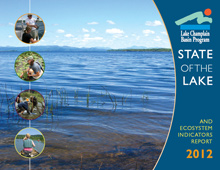How is Lake Champlain doing? The Lake Champlain Basin Program released a new State of the Lake report this summer that helps answer that question. The State of the Lake comes out every three to four years to report on progress meeting water protection and restoration goals, track changes in the lake’s condition, and answer frequently asked questions. Topics covered include phosphorus, human health and toxins, biodiversity and aquatic invasive species, climate change, 2011 flooding, and recreation and tourism.
Unfortunately, the report shows that in-lake phosphorus concentrations are increasing for much of the lake. However, there is no overall upward or downward trend in phosphorus loading to the lake during recent years except decreases in a few tributaries and decreases from wastewater treatment facilities.
The report also expressed concern about invasive species on the doorstep of the lake, including spiny waterflea, round goby, and Asian clam. While there are currently 49 non-native species in Lake Champlain, there are many more in adjacent basins. The Great Lakes host 184 non-native species; the Hudson River hosts 122; and the St. Lawrence River hosts 87. All of these systems are connected to Lake Champlain via canals. On a positive note, in the southern portion of Lake Champlain, water chestnut populations have been reduced back to about 6.5 miles south of Benson, Vermont, their southernmost point since 1991. More than 200 acres were mechanically harvested in 2011. Other gains include declines in mercury levels in walleye, lake trout, and yellow perch. Fish mercury levels should continue to improve with newly issued US EPA regulations on mercury emissions from coal-fired power plants.
“The report illustrates, that while progress is being made, much more work needs to be done,” said Lori Fisher, LCC Executive Director. “In an ecological system as large and complex as Lake Champlain, there’s always good news and bad news. Protecting and restoring lake health requires a continuous investment of resources, new approaches, and ongoing stewardship.”
Click here to download a PDF of the report.
